“Empower Your Independence: Essential Insights for Off-Grid Solar Wiring.”
Solar wiring for off-grid systems is a crucial aspect of setting up a self-sufficient energy solution that operates independently from the traditional power grid. Understanding the fundamentals of solar wiring is essential for ensuring safety, efficiency, and reliability in your solar energy system. This introduction covers the key components involved, including solar panels, charge controllers, batteries, inverters, and the necessary wiring techniques. Proper installation and configuration of these elements are vital for optimizing energy production, storage, and usage. Whether you are a DIY enthusiast or a seasoned installer, grasping the principles of solar wiring will empower you to create a sustainable and effective off-grid power system.
Understanding Solar Wiring Basics for Off-Grid Systems
When venturing into the world of off-grid solar systems, understanding the basics of solar wiring is crucial for ensuring a safe and efficient setup. At its core, solar wiring involves the connections between various components of the solar power system, including solar panels, charge controllers, batteries, and inverters. Each of these elements plays a vital role in harnessing solar energy and converting it into usable electricity. Therefore, grasping the fundamentals of how these components interact is essential for anyone looking to establish an off-grid solar system.
To begin with, solar panels are the heart of any solar power system, converting sunlight into direct current (DC) electricity. When wiring solar panels, it is important to consider the configuration—whether they are connected in series or parallel. Connecting panels in series increases the voltage, while parallel connections increase the current. The choice between these configurations depends on the specific requirements of the system, such as the voltage rating of the charge controller and the battery bank. Understanding these configurations allows for optimal energy production and ensures that the system operates within safe limits.
Once the solar panels generate electricity, the next component in the chain is the charge controller. This device regulates the voltage and current coming from the solar panels to the batteries, preventing overcharging and ensuring that the batteries are charged efficiently. When wiring the charge controller, it is essential to follow the manufacturer’s guidelines regarding wire gauge and length to minimize voltage drop and ensure reliable performance. Additionally, incorporating fuses or circuit breakers in the wiring can provide an extra layer of protection against potential short circuits or overloads.
After the charge controller, the electricity is stored in batteries, which serve as the energy reservoir for off-grid systems. When selecting batteries, it is important to consider their type—lead-acid or lithium-ion—and their capacity, as these factors will influence the overall performance of the system. Proper wiring of the battery bank is critical; batteries should be connected in series or parallel based on the desired voltage and capacity. Furthermore, using appropriate gauge wire is essential to handle the current without overheating, which can lead to safety hazards.
The final component in the solar wiring process is the inverter, which converts the stored DC electricity from the batteries into alternating current (AC) electricity for household use. When wiring the inverter, it is important to ensure that it is compatible with the battery bank’s voltage and that the connections are secure. Additionally, proper grounding of the inverter is necessary to prevent electrical shocks and ensure safe operation.
In conclusion, understanding solar wiring basics for off-grid systems is fundamental for anyone looking to harness solar energy effectively. By grasping the roles of solar panels, charge controllers, batteries, and inverters, individuals can create a reliable and efficient solar power system. Moreover, paying attention to wiring configurations, using appropriate wire gauges, and incorporating safety measures will not only enhance the performance of the system but also ensure its longevity. As the demand for renewable energy continues to grow, mastering these wiring fundamentals will empower individuals to take control of their energy needs and contribute to a more sustainable future.
Essential Components of Off-Grid Solar Wiring
When considering the installation of an off-grid solar system, understanding the essential components of solar wiring is crucial for ensuring efficiency and safety. At the heart of any off-grid solar setup lies the solar panels, which convert sunlight into electricity. These panels are typically connected in series or parallel configurations, depending on the desired voltage and current output. The choice of configuration directly impacts the overall performance of the system, making it essential to understand how these connections work.
Once the solar panels are in place, the next critical component is the charge controller. This device regulates the voltage and current coming from the solar panels to the batteries, preventing overcharging and ensuring that the batteries are charged efficiently. There are two main types of charge controllers: PWM (Pulse Width Modulation) and MPPT (Maximum Power Point Tracking). While PWM controllers are generally less expensive and simpler, MPPT controllers are more efficient, especially in systems where the solar panel voltage is significantly higher than the battery voltage. Therefore, selecting the right charge controller is vital for optimizing energy storage and prolonging battery life.
Following the charge controller, the energy generated by the solar panels is stored in batteries, which serve as the backbone of any off-grid system. The choice of battery type—whether lead-acid, lithium-ion, or another technology—will influence the wiring requirements and overall system performance. Lead-acid batteries, for instance, require careful management to avoid sulfation, while lithium-ion batteries offer higher energy density and longer life cycles but come at a higher initial cost. Regardless of the type chosen, proper wiring is essential to ensure that the batteries are connected safely and efficiently, allowing for optimal energy storage and retrieval.
In addition to these primary components, the inverter plays a pivotal role in off-grid solar systems. The inverter converts the direct current (DC) generated by the solar panels and stored in the batteries into alternating current (AC), which is used by most household appliances. When selecting an inverter, it is important to consider the total wattage of the appliances that will be powered, as well as the inverter’s efficiency rating. A well-sized inverter will ensure that your system can handle peak loads without overloading, thus maintaining a steady supply of electricity.
Moreover, the wiring itself is a critical aspect of the entire system. Using the correct gauge of wire is essential to minimize voltage drop and ensure safety. Thicker wires can carry more current with less resistance, which is particularly important in longer runs between components. Additionally, all connections should be secure and weatherproofed to prevent corrosion and ensure longevity. Proper grounding is also necessary to protect the system from electrical surges and lightning strikes, further enhancing safety.
Finally, it is important to consider the layout of the entire system. A well-planned design not only facilitates easier installation but also enhances the overall efficiency of the solar wiring. By strategically placing components and minimizing the distance between them, you can reduce energy loss and improve the system’s performance.
In conclusion, understanding the essential components of off-grid solar wiring is fundamental for anyone looking to harness solar energy effectively. From solar panels and charge controllers to batteries and inverters, each element plays a vital role in creating a reliable and efficient off-grid system. By paying careful attention to wiring, component selection, and system layout, you can ensure that your off-grid solar installation meets your energy needs while providing a sustainable solution for years to come.
Common Wiring Mistakes in Off-Grid Solar Installations
When embarking on an off-grid solar installation, understanding the common wiring mistakes is crucial for ensuring both safety and efficiency. Many individuals, eager to harness the power of the sun, often overlook the intricacies of wiring, which can lead to significant issues down the line. One prevalent mistake is the use of undersized wiring. Inadequate wire gauge can result in excessive voltage drop, which diminishes the performance of the solar system. It is essential to calculate the appropriate wire size based on the distance between the solar panels, battery bank, and inverter. By doing so, you can minimize energy loss and ensure that your system operates at peak efficiency.
Another frequent error involves improper connections. Many DIY enthusiasts may underestimate the importance of secure and correct connections, leading to loose or corroded terminals. Such issues can create resistance in the circuit, resulting in overheating and potential fire hazards. To avoid this, it is vital to use high-quality connectors and ensure that all connections are tight and well-insulated. Additionally, employing proper techniques for crimping and soldering can further enhance the reliability of your wiring.
Moreover, neglecting to follow the correct polarity is a mistake that can have dire consequences. Connecting the positive and negative terminals incorrectly can damage components such as the charge controller and batteries. It is advisable to double-check all connections before powering up the system. Using color-coded wires can help mitigate this risk, as it provides a visual cue that reinforces correct wiring practices.
Furthermore, failing to account for environmental factors can lead to premature system failure. For instance, using standard wiring in areas prone to extreme temperatures or moisture can result in insulation breakdown and corrosion. To combat this, it is essential to select wiring that is rated for outdoor use and can withstand the specific environmental conditions of your installation site. This proactive approach not only enhances the longevity of your system but also ensures consistent performance.
In addition to these technical aspects, many installers overlook the importance of proper grounding. Grounding is a critical safety measure that protects both the system and its users from electrical surges and lightning strikes. A common mistake is to neglect a dedicated grounding system or to use inadequate grounding methods. Implementing a robust grounding strategy, including grounding rods and bonding all metal components, is essential for safeguarding your investment.
Another area where mistakes often occur is in the layout of the wiring. A disorganized wiring setup can lead to confusion during maintenance and troubleshooting. It is advisable to plan the layout meticulously, using cable ties and conduits to keep wires organized and protected. This not only enhances the aesthetic appeal of the installation but also simplifies future repairs or upgrades.
Lastly, many individuals fail to consult local codes and regulations when installing their off-grid solar systems. Ignoring these guidelines can result in unsafe installations and potential legal issues. It is crucial to familiarize yourself with local electrical codes and, if necessary, consult with a professional to ensure compliance. By being aware of these common wiring mistakes and taking proactive measures to avoid them, you can create a safe, efficient, and reliable off-grid solar system that meets your energy needs for years to come.
Safety Tips for Wiring Off-Grid Solar Systems
When embarking on the journey of setting up an off-grid solar system, safety should be your foremost concern, particularly when it comes to wiring. Proper wiring is crucial not only for the efficiency of your system but also for the safety of your home and those who inhabit it. To begin with, it is essential to understand the components involved in an off-grid solar system, which typically includes solar panels, charge controllers, batteries, and inverters. Each of these components must be wired correctly to ensure optimal performance and safety.
First and foremost, always use the appropriate gauge of wire for your system. The wire gauge is critical because it determines how much current can safely pass through without overheating. Using a wire that is too thin can lead to excessive heat buildup, which poses a fire risk. Conversely, using a wire that is too thick can be unnecessarily expensive and cumbersome. Therefore, consult the National Electrical Code (NEC) or a qualified electrician to determine the correct wire gauge based on the current and distance involved in your setup.
In addition to selecting the right wire gauge, it is vital to ensure that all connections are secure and properly insulated. Loose connections can lead to arcing, which not only reduces efficiency but can also ignite a fire. To mitigate this risk, use high-quality connectors and ensure that they are crimped or soldered correctly. Furthermore, all exposed wires should be insulated with heat-shrink tubing or electrical tape to prevent accidental contact with conductive materials, which could lead to short circuits.
Moreover, when installing your solar system, consider the environmental factors that may affect your wiring. For instance, if your system is exposed to moisture, it is crucial to use weatherproof enclosures and corrosion-resistant materials. This is particularly important for outdoor installations, where rain, snow, and humidity can compromise the integrity of your wiring. Additionally, UV-resistant cables should be used to prevent degradation from prolonged sun exposure.
Another critical aspect of safety in off-grid solar wiring is grounding. Proper grounding protects your system from electrical surges and lightning strikes, which can cause significant damage. Ensure that your solar panels, inverter, and battery bank are all grounded according to local codes. This typically involves connecting a grounding wire from each component to a grounding rod driven into the earth. This simple yet effective measure can safeguard your investment and enhance the longevity of your system.
Furthermore, it is advisable to incorporate circuit breakers or fuses into your wiring setup. These devices act as safety valves, interrupting the flow of electricity in the event of an overload or short circuit. By installing circuit breakers or fuses, you can prevent potential damage to your equipment and reduce the risk of fire. It is essential to choose the right ratings for these devices based on the specifications of your system.
Lastly, always prioritize personal safety when working with electrical systems. Wear appropriate personal protective equipment, such as gloves and safety glasses, and ensure that you are working in a dry environment. If you are unsure about any aspect of the installation, do not hesitate to consult a professional. The complexities of electrical systems can be daunting, and seeking expert advice can save you time, money, and potential hazards.
In conclusion, wiring an off-grid solar system requires careful consideration of safety protocols. By selecting the right materials, ensuring secure connections, grounding your system, and incorporating protective devices, you can create a safe and efficient solar setup. Remember, taking the time to prioritize safety will not only protect your investment but also provide peace of mind as you harness the power of the sun.
Q&A
1. **What is the purpose of a charge controller in an off-grid solar system?**
A charge controller regulates the voltage and current coming from the solar panels to the batteries, preventing overcharging and ensuring optimal battery health.
2. **What type of wiring is recommended for connecting solar panels in an off-grid system?**
Use UV-resistant, stranded copper wire with appropriate gauge (typically 10-12 AWG) to handle the current and minimize voltage drop.
3. **How do you determine the correct size of the inverter for an off-grid solar system?**
Calculate the total wattage of all appliances that will be used simultaneously, then choose an inverter that can handle at least 20% more than that total to account for surges.
4. **What safety measures should be taken when wiring an off-grid solar system?**
Ensure all connections are secure and weatherproof, use fuses or circuit breakers to protect against overloads, and follow local electrical codes and standards.
Conclusion
When setting up solar wiring for off-grid systems, it is essential to understand the components involved, including solar panels, charge controllers, batteries, and inverters. Proper sizing of wires to handle the current load, ensuring correct polarity, and implementing safety measures such as fuses and circuit breakers are crucial. Additionally, familiarity with local codes and regulations is important for compliance. Overall, careful planning and execution of solar wiring can enhance system efficiency, safety, and longevity.




